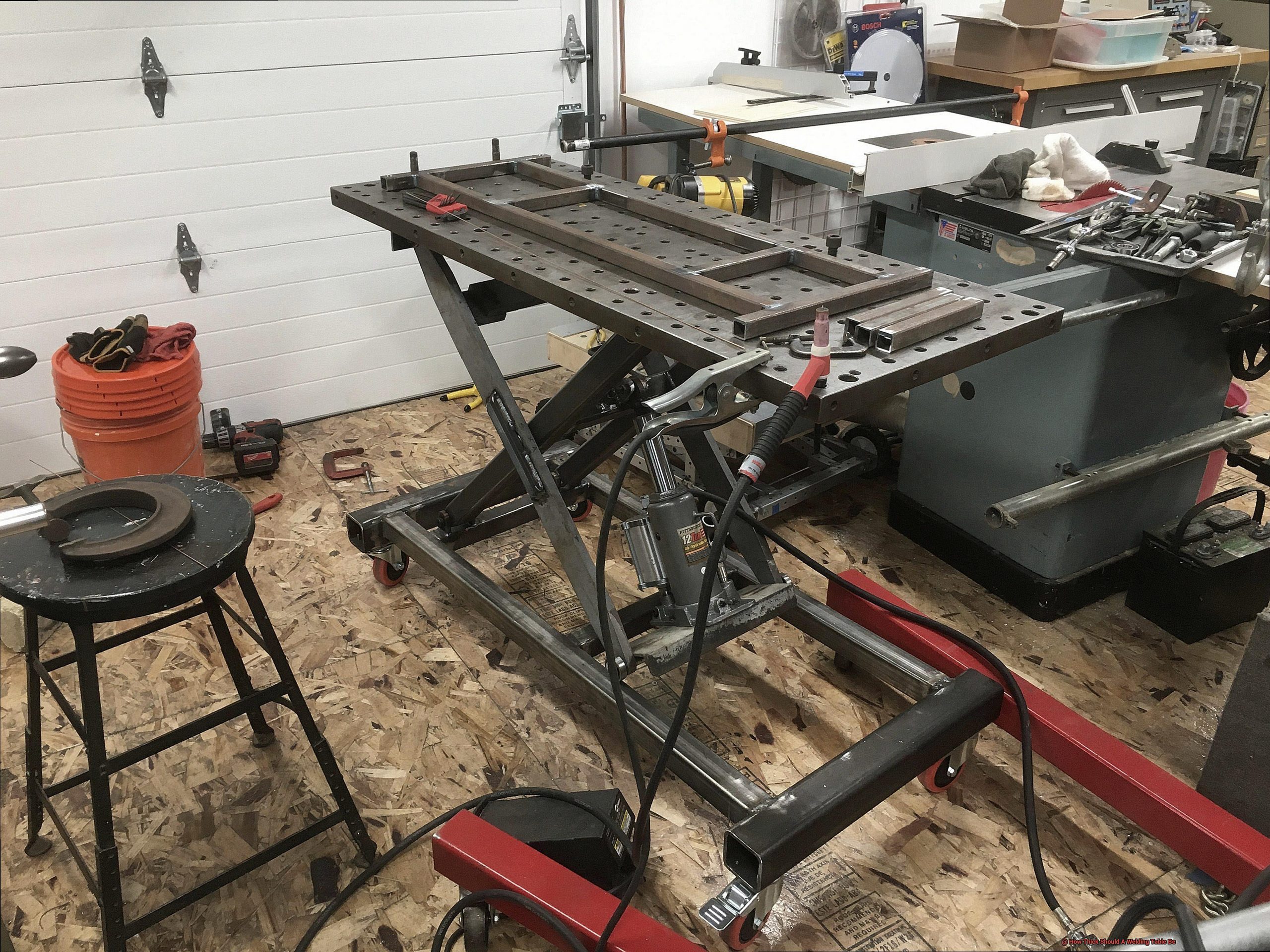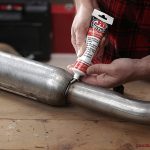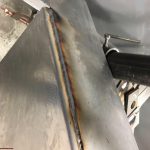As a welder, you know that a strong and durable welding table is the foundation of any successful project. But when it comes to determining the appropriate thickness for your welding table, things can get a bit tricky.
The truth is, the thickness of your welding table plays a critical role in the quality of your work. A sturdy and thick table will provide stability during the welding process, preventing wobbling or movement that could negatively impact your finished product. Additionally, the thickness will determine how much weight your table can handle, which is vital information when selecting a welding table.
In this blog post, we’ll dive deep into the details of how thick a welding table should be. We’ll examine all the factors you need to consider when choosing an appropriate thickness for your specific needs. From exploring various types of welding tables on the market to highlighting their unique features, we’ll cover everything you need to know about finding the perfect fit for your projects.
Whether you’re an experienced welder or just starting out in this exciting field, understanding how thick your welding table should be is crucial knowledge. Join us as we explore this topic and equip you with all the information you need to tackle any welding project with confidence.
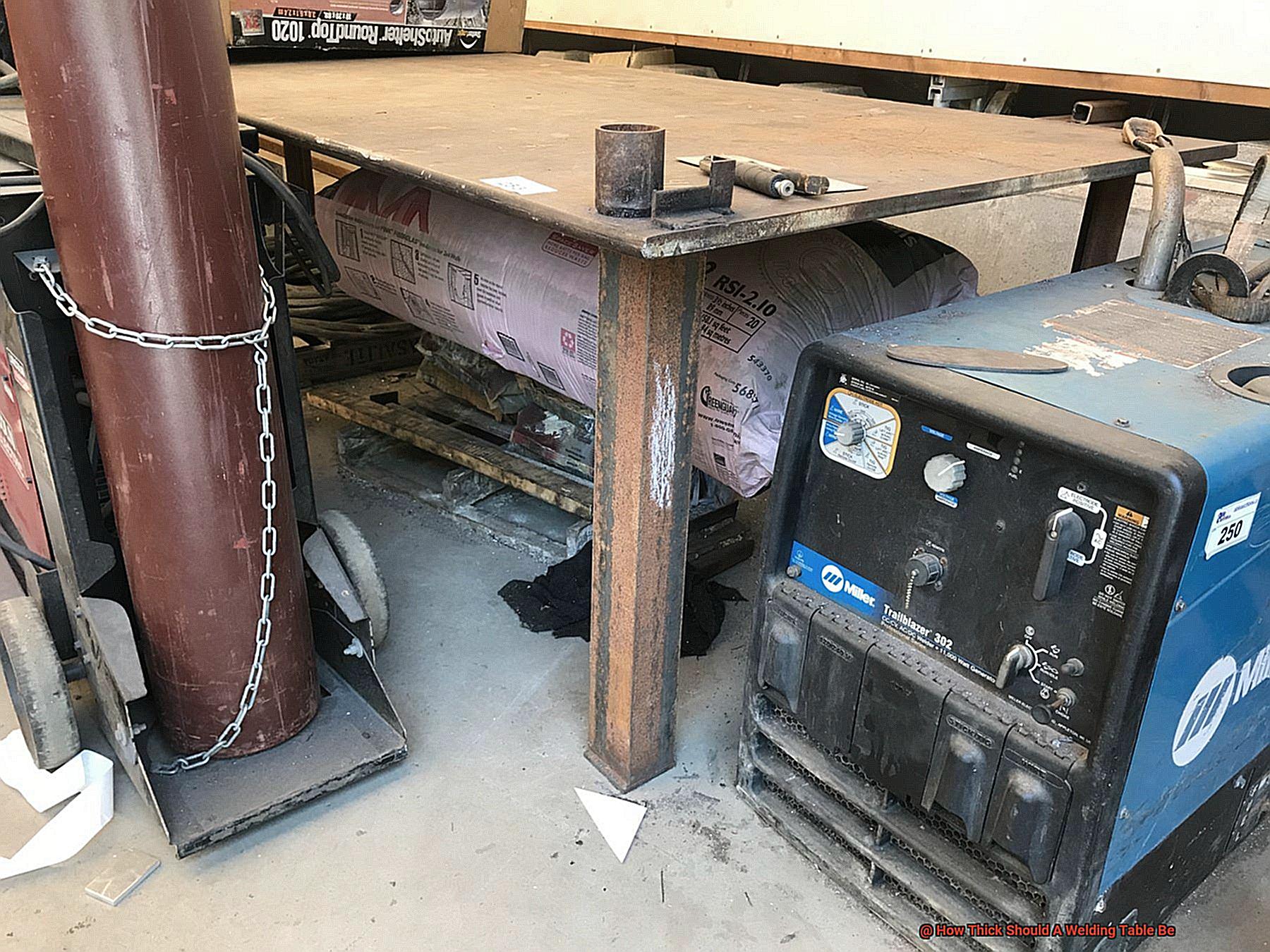
What Is Welding Table
Contents
- 1 What Is Welding Table
- 2 What Is Thickness Considerations
- 3 Types of Welding Tables
- 4 Benefits of Using A Thick Welding Table
- 5 Factors to Consider When Choosing A Welding Table Thickness
- 6 Different Thicknesses for Different Materials
- 7 Importance of Consistent Thickness Across The Surface Of The Table
- 8 Conclusion
A welding table is a flat surface that is specifically designed for welding, cutting, and grinding metal. It provides a stable working platform for welders and holds tools and equipment such as clamps.
When choosing a welding table, one of the most critical factors to consider is its thickness. The thickness of the table determines its strength, durability, and resistance to warping or bending under heat and pressure. In general, a welding table should be at least 1/2 inch thick. However, the thickness may vary depending on the type of material being welded, the size of the table, and the amount of heat generated during welding.
Think of it this way – just like how you need a solid foundation to build a sturdy house, you need a thick and consistent surface to achieve high-quality welds. A thinner table may suffice if you’re working with thin sheets of metal, but if you’re dealing with thicker plates or heavy-duty materials, a thicker table may be necessary.
It’s crucial to ensure that the thickness is consistent throughout the entire surface because variations in thickness can cause warping or distortion during welding. In addition to thickness, other factors to consider when selecting or building a welding table include size and shape. Welding tables come in different sizes and shapes depending on your needs as a welder. Some tables are small enough to be portable, while others are large enough to accommodate big projects. A typical welding table is rectangular or square in shape with a flat surface and four legs.
The surface of a welding table is usually made of steel plate which can range in thickness from 1/4 inch to 1 inch or more. The thickness of the plate will depend on the intensity of use and type of welding that will be done on it. Thicker plates are suitable for heavy-duty welding jobs that require high temperatures and pressure, while thinner plates are perfect for lighter welding tasks.
Finally, a good welding table should be sturdy, flat, and resistant to heat and damage. Choose a table that suits your needs and maintain it properly to ensure safe and efficient welding work. Keep in mind that welding tables may also have additional features such as clamps, vices, or fixtures to hold the workpiece in place during welding. Some tables may even have built-in ventilation systems to help remove fumes and smoke from the welding area.
What Is Thickness Considerations
When it comes to welding, the foundation of your projects is the welding table. Just like a stable and firm foundation is crucial for a building’s stability, the thickness of a welding table is critical to its strength and durability.
So, what should you consider when selecting a welding table? Well, experts suggest a minimum thickness of 1/4 inch or 6mm. This thickness provides enough strength to support most welding applications without warping or distortion.
However, if you’re planning on using your welding table for heavy-duty applications, such as welding thick or heavy metals, you’ll need to go thicker. A thicker table can handle the heat and pressure of welding without buckling under the weight.
Bear in mind that the thickness of the table also affects its weight. A heavier table can be more stable during welding but can be more challenging to move around your workshop. So, it’s essential to balance stability and mobility when selecting your table’s thickness.
To ensure your welding table is strong and durable, you should also consider the material used and the construction method. A high-quality steel table constructed with precision welding techniques will always be stronger and last longer than one made from lower quality materials.
Besides, it’s important to consider the size of your welding table when determining its thickness. A larger table will require more support, and therefore a thicker material is necessary to ensure stability during use.
Types of Welding Tables
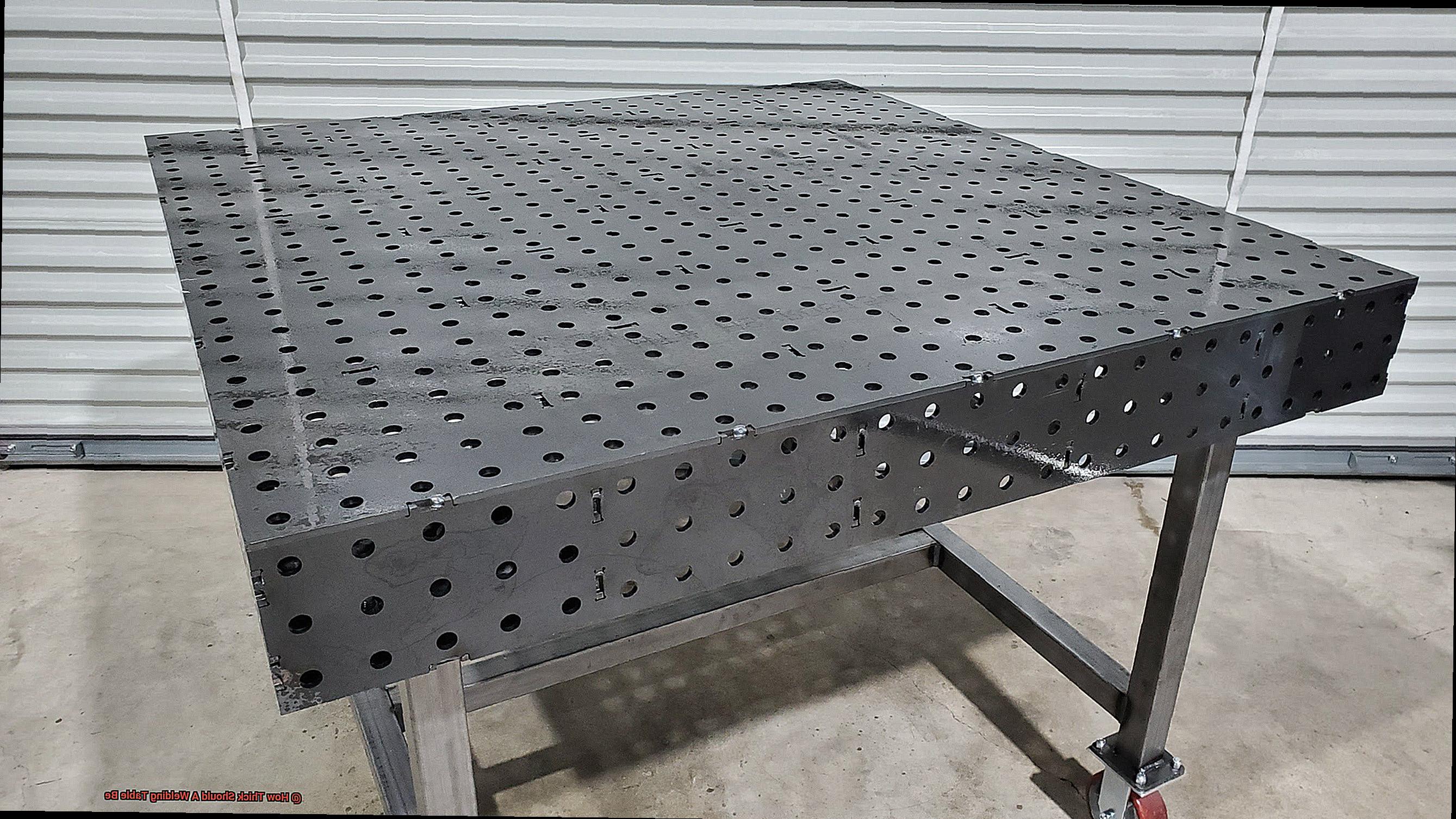
When it comes to welding, having the right tools is essential to create your masterpiece. Just like a chef needs a solid cutting board to prepare a delicious meal, a welder needs a strong and durable table to work on. But with so many different types of welding tables available, it can be overwhelming to choose the right one. Don’t worry, we’ve got you covered.
First up, let’s start with the most popular type of welding table – the steel welding table. Made from heavy-duty steel, these tables are sturdy and can handle a lot of weight and pressure. They are also resistant to heat, which is important when welding. Think of it as the heavyweight champion of welding tables – it may not be the most agile, but it can definitely handle the toughest jobs.
If you’re looking for something more lightweight and portable, an aluminum welding table may be the way to go. These tables are perfect for small projects or for those who need to move their workspace frequently. However, aluminum is not as strong as steel, so it may not be suitable for larger projects.
For those on a tighter budget, a wood welding table may be a good option. Typically made from hardwood, these tables are cheaper than metal tables and great for those who only need a table for occasional use. However, wood is not as durable as metal, so it may not be suitable for heavy-duty projects.
Finally, we have modular welding tables – the chameleons of the welding world. These tables are versatile and can be customized to fit your specific needs. They come in a variety of shapes and sizes and can be adjusted to different heights. And just like their steel counterparts, they are also typically made from heavy-duty steel, making them very durable.
Now that we’ve covered the different types of welding tables, let’s talk about thickness.
The thickness of your welding table will depend on the material it’s made from and how much weight it needs to support.
Steel welding tables typically have a thickness of at least 1 inch, while wood tables may only need to be half an inch thick. It’s important to choose a table that is strong enough to handle the weight and heat generated during welding to ensure safety and quality in your work.
Benefits of Using A Thick Welding Table
As a welder, you know that every detail counts when it comes to producing high-quality work. And one vital detail that can make a significant difference is the thickness of your welding table. In fact, using a thick welding table can offer a range of benefits that make it an essential tool for any professional or hobbyist welder.
Firstly, a thick welding table provides a stable and sturdy surface for your workpiece. It can withstand the intense heat, pressure, and vibrations that are generated during welding without warping or bending. This ensures that your workpiece stays in place, reducing the risk of accidents and producing welds of the highest quality.
But that’s not all- a thick welding table also acts as a heat sink, preventing excessive heat from transferring to the surface underneath. This is crucial when working with delicate materials like aluminum or thin sheet metal where excessive heat can cause warping or distortion. The thick table absorbs excess heat and prevents it from transferring to the surrounding area, ensuring your workpiece stays intact.
Another benefit of using a thick welding table is the ample room for clamping and securing your workpiece in place. This is critical for achieving accuracy and precision during the welding process. With more space to clamp your workpiece, you can align it better and reduce the risk of movement or slippage during welding.
And finally, a thick welding table is more durable and long-lasting than thinner alternatives. It can withstand years of heavy use without showing signs of wear and tear, making it a worthwhile investment for any serious welder.
Factors to Consider When Choosing A Welding Table Thickness
As a welding professional, you know that having a reliable and sturdy welding table is essential to getting the job done right. But how do you choose the right thickness that will meet your needs? Well, there are several factors to consider when making this decision.
Firstly, let’s talk about the type of welding you’ll be doing. Different types of welding require different levels of heat and pressure, which means you’ll need to adjust your table thickness accordingly. For instance, MIG and TIG welding won’t need as thick of a table as you would for stick welding.
Another crucial factor to consider is the size and weight of the materials you’ll be welding. If you’re working with larger or heavier materials, you’ll need a thicker table to handle the weight and prevent warping or bending during the welding process. A wobbly table can lead to a wobbly weld, and we don’t want that.
The material of the table itself is also critical. Don’t be tempted to opt for a cheaper, low-quality material; it could end up costing you in the long run. Tables made from high-quality materials like steel or cast iron can withstand the heat and pressure generated during welding and are less likely to warp or become damaged.
Finally, think about the size of your project. If you’re working on a larger project, you’ll want a thicker table to provide adequate support and prevent any warping or bending. Smaller projects may not require as much thickness but remember that choosing a thicker table will never hurt.
A thick welding table is like a reliable partner for a welder, providing stability, preventing heat transfer, offering ample clamping space, and lasting longer than thinner alternatives.
Different Thicknesses for Different Materials
Selecting the perfect thickness for your welding table is like selecting the perfect tool for a job; it’s crucial to get it right. Different materials require different thicknesses, and it’s vital to consider the material being welded and the amount of heat it can withstand.
For instance, if you’re welding thin materials like aluminum or sheet metal, a thinner table would suffice. A 1/4 inch thick table would provide stability and prevent warping. However, if you’re working with thicker materials such as steel plates, a thicker table is necessary. A 1/2 inch thick table would be ideal for such jobs.
But it’s not just about material thickness. The type of welding you’ll be doing also plays a significant role in selecting the right thickness. MIG welding generates more heat than other types of welding, so a thicker table is necessary to withstand the heat and prevent warping.
Think of your welding table as your trusty sidekick. You want it to have your back no matter what task you’re tackling. Therefore, you need to ensure that the table is thick enough to provide stability, prevent warping, and offer ample clamping space.
When selecting the thickness of your welding table, consider not only the material being welded but also the type of welding being done. By doing so, you’ll have a reliable partner that will make your welding projects more manageable and enjoyable.
Importance of Consistent Thickness Across The Surface Of The Table
Precision is key when it comes to welding, and the importance of having a welding table with consistent thickness across its surface cannot be overstated. An uneven surface can lead to distortions in the metal or even cause the weld to fail altogether. To avoid this, it’s crucial to have a table that is flat and uniform in thickness.
Think of a welding table like a baking pan. If the pan isn’t level, the cake won’t bake evenly. Similarly, if the thickness of the welding table isn’t consistent across its surface, your welds will be off, and your project won’t turn out as planned. This can be frustrating and costly, not to mention a waste of time, effort, and materials.
To ensure accuracy and precision in your welding projects, it’s necessary to have a stable base for welding. A consistent thickness across the entire surface of the table provides just that. You can achieve this by using a milling machine or grinder to level out any high spots or dips in the surface. This will prevent unwanted movements or vibrations during the welding process.
Determining the ideal thickness for your welding table depends on various factors such as size, material type, and heat generated during welding. Generally, a thickness of at least 1/2 inch is recommended for small to medium-sized tables, while larger tables may require up to 1 inch.
Maintaining the surface of your welding table is also essential. Any dents or scratches on the surface should be smoothed out immediately to prevent distortion in the metal being welded. Keeping the surface clean and free from debris will also prevent contamination of the welds.
9c6ZVmbhE5Q” >
Conclusion
To wrap things up, the thickness of your welding table is an essential consideration that can impact both the quality and safety of your welding projects. A sturdy and thick table provides stability during welding, preventing any unwanted movement or wobbling that could negatively affect your finished product. It also determines how much weight your table can handle, which is crucial to know when selecting a welding table.
When choosing a welding table, you need to consider various factors such as material type, size and weight of materials being welded, heat generated during welding, and construction method. In general, experts recommend a minimum thickness of 1/4 inch or 6mm for most applications. However, if you’re planning on using your welding table for heavy-duty applications or larger projects, you’ll need to go thicker.
Different types of welding require different levels of heat and pressure; therefore, it’s vital to adjust your table’s thickness accordingly. Thick tables provide stability during the welding process while preventing heat transfer and offering ample clamping space.
Additionally, it’s crucial to ensure that the thickness is consistent throughout the entire surface because variations in thickness can cause warping or distortion during welding.
